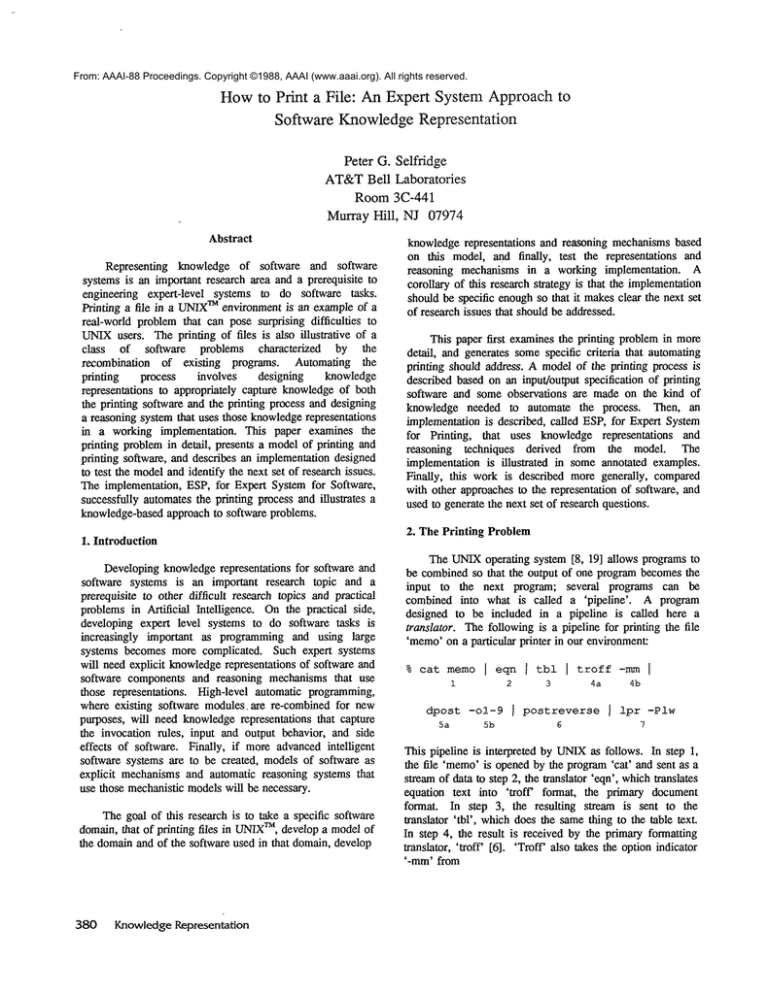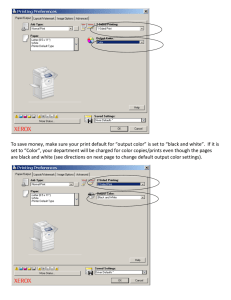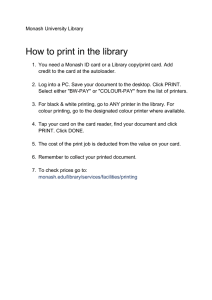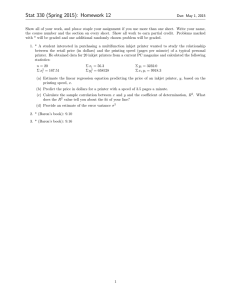
From: AAAI-88 Proceedings. Copyright ©1988, AAAI (www.aaai.org). All rights reserved.
the command line, step 4b, which tells it to use a particular
macro package for deciphering certain macro commands
present in the text. The output of ‘troff’ is a ‘troff’ file,
where the text has been completely replaced by troff
commands. The final destination of the data stream, step 7,
indicated by ‘lpr -Plw’, is a particular printer, the ‘lw’ (laser
writer) printer. This printer is a ‘PostScript’ [11,12] printer
which takes data in the ‘PostScript’ format. Therefore, step
5 is required, where the translator ‘dpost’ translates ‘troff’
format into ‘PostScript’ format. ‘Dpost’ is given another
option in step 5b, an option that specifies which subset of
the document should be printed; in this case, the pages 1
through 9. Finally, the translator ‘postreverse’is needed in
step 6 to order the pages properly front to back.
Generating an appropriate pipeline can be difficult for
many reasons. First of all, one needs to know all of the
different kinds of text present in the file. Second, one needs
to know what translators are needed to process the file, how
to invoke them, and the order in which they must appear.
Third, some options (like ‘-mm’ above) are critical to the
final appearance of the printed document and must be
included in the proper place. Fourth, an appropriate printer
must be chosen and not all printers can print all kinds of
files. Fifth, for a given printer, other translators may be
needed, and other options may be desired which have to be
properly invoked and included in the proper place in the
pipeline. Sixth, detecting that a printer is ‘down’ or
otherwise inaccessible, or has a prohibitively long queue of
current printing jobs, must be done from time to time.
Finally, users typically use a given printer and options most
of the time, so that using defaults correctly becomes part of
the problem.
Automating the printing process is an important
research project for two reasons. First of all, from a
practical point of view, such a system would be quite useful.
More important, the printing problem is representative of a
class of software problems which involve the recombination
of existing programs. Recombining existing programs [26]
is likely to become a very important mechanism for creating
software, as well as aid in the problems of understanding,
debugging, and revising software. Progress on the printing
problem should identify the next set of research issues
relevant to the larger problem of automatic programming by
program recombination.
Representing software knowledge for automatic
programming has been addressed by a number of
researchers. Rich and Waters, and others, have developed
the “programmer’s apprentice” framework [15-18, 22, 231
and various techniques for representing knowledge of
specifm program constructs. Their techniques address a
lower level of automatic programming and representation of
software knowledge, and are not directly applicable to the
problem of automatic recombination of existing programs.
Wilensky’s UNIX consultant (UC.) project [23-251 addresses
the representation of software knowledge to help the user
find particular UNIX commands, but does not address the
combining of commands to achieve other goals. Other
research into automatic programming almost exclusively use
the
“transformation
approach”, which
represents
programming knowledge as correctness-preservingsyntactic
transformations applied to a semantically correct program
“specification” [2,3,7,20]. Transformation approachesare not
applicable to program re-combination, being specifically
tailored to the construction of small programs for specific
low-level computations.
In summary, the problem of printing files in UNIX and
the goal of automating this task is of both practical and
theoretical importance, and generates the following specific
problems that must be addressed in both a model of the
domain and the implementation:
1. how
2. how
3. how
4. how
5. how
are translators and options chosen?
are they properly ordered?
are printers selected?
can user defaults be handled?
can erroneous printer output be minimized?
ode1 of File Types and File Printing
This section describes a model of printing files in a
UNIX environment. The general model is based on the
observation that the file to be printed (including data flowing
through a pipeline) can be viewed as an object with a set of
properties or types, each type representing one kind of text
in the file. With this view, a translator can be modelled as
an operator that changes the set of types of the data object, a
printer can be modellcd as a terminal operator that can only
accept data of a specific type, user defaults can be modelled
as demons, and the printing process can be modelled as a
sequence of operations to detect the file types, select a
printer, select the translators, and order them to produce the
final pipeline.
With this general model in mind, the specific types of
knowledge needed and their general representation need to
be identified. There are three categories of “objects” for
which knowledge is needed: file types, translators, and
printers. The kinds of knowledge are listed here:
Knowledge of files types:
- text patterns that indicate file types
Knowledge of translators:
- translator input type
- translator output type
- translator order
- translator invocation
- possible options
Selfridge
381
[251, is needed.
The system has no representation for the invocation of a
piece of software; it assumes all translators can be included
in a UNIX pipeline. In fact, this was not the case with the
programs ‘latex’ and ‘dvi2ps’, which had to be embedded in
other programs for this to be true. The invocation pattern
and side effects of using ‘latex’ are complicated: ‘latex’
takes a command line argument which is the first part of the
file name, and the extension ‘tex’ is assumed. In addition,
several log files are created as a side effect and particular
things happen when certain kinds of errors occur. In order
for a system to deal with these kinds of things intelligently,
it needs a comprehensive representation of the invocation
patterns, side effects, and normal behavior of software and
software systems. In order to do this, an underlying process
model of the entire environment, including the file system,
terminal input and output, and storage allocation is needed.
Research into representing knowledge of software and
software systems is an important and growing area, and this
work has only touched the surface. Several areas for future
work suggestion themselves, partly derived from the
limitations of the current system. First of all, a more
complicated domain is needed. One possibility is to try to
apply the software knowledge representation techniques used
here to the problem of information retrieval of software,
allowing the retrieval of appropriate software modules based
on a functional description of the software and its behavior.
In order to do this, more advanced representation
techniques will be necessary. These techniques should first
be applied to representing the underlying software
environment of UNIX: the file system, UNIX invocation
patterns, and terminal interactions, all of which can get very
complicated. Once the environment is described, software
which is embedded in that environment can be more
completely represented.
Finally, this work has not been concerned with how
people think about software [41. A more cognitive approach
should elucidate the kinds of models people have about
software and software systems (how a file gets printed would
be a good initial domain) and should also shed light on how
people detect and fix various kinds of errors in the process
and in their model of the process. Such knowledge should
help us in designing knowledge representations of software
and systems to use those representations.
7. Conclusion
This paper has described a certain approach to the
representation of knowledge about software. We identified a
domain, that of printing files in a UNIX environment, which
is an good example of a complex software system, yet
tractable from the representation point of view. We explored
384
Knowledge Representation
the kinds of knowledge that needed to be represented, and
built representations of the different software components of
the printing process. The implementation, ESP, used those
representations and achieved almost all of the performance
goals. Most important, this work serves to highlight the next
set of research issues to be addressedin the area of software
knowledge
representation, which
include
deeper
representations of software objects, including module
invocation and side effects: representation of the underlying
software environment, including the file system, memory
allocation, and the terminal interface; and investigation of
human cognitive models of software.
8. Acknowledgements
I would like to thank Ron Brachman, Dewaynne Perry, and
Bruce Ballard for reading and commenting on earlier
versions of this paper. Special thanks to Mallory Selfridge
for several “hard edits” that were instrumental in improving
the overall quality of the paper.
9. References
1. Barth, P., Buthery, S., Barstow, D., The Stream Machine:
A Data Flow Architecture, 8th International Software
Engineering Conference: 103-110, 1986
2. Barstow, D., Automatic Programming for Streams, IJCAI
‘85: 232-237, 1985
3. Barstow, D., Knowledge-Based Program Construction,
North-Holland, 1979
4. Bobrow, D., Ed., Qualitative Reasoning About Physical
Systems, MIT Press, 1985
5. Brownston, L., Farrell, R., Kant, Elaine, Martin, N.,
Programming Expert Systems in OPS5: an
Introduction
to
Rule-Based
Programming,
Addison-Wesley, 1986
6. Gehani, N., Document Formatting and Typesetting on
the UNIX System, Silicon Press, NJ, 1986
7. Goldberg, A.T., Knowledge-Based Programming: A
Survey of Program Design and Construction
Techniques, IEEE Trans. on SE Se-12 752-768, 1986
8. Kemighan, B. W., Pike, R., The UNIX Programming
Environment, Prentice-Hall, NJ, 1984
9.
Perry, D. E., Software Interconnection Models,
Proceedings of the 9th International Conference on
Software Engineering, 1987
10. Pesch, H., Shaller, H., Test Case Generation Using
,
PdOg,
in 8th International Conference on Software
Engineering p. 252-258, 1985
11. PostScript Language Reference Manual, Adobe
Systems Incorporated, published by Addison-Wesley,
Inc. 1985
25. Wilensky, R., Some Problems and Proposals for
Knowledge Representation, Report no. UCB/CSD
87/351, May, 1987
26. IEEE Software, Special Issue on Reuse, January, 1988
12. PostScript Language Tutorial and Cookbook, Adobe
Systems Incorporated, published by Addison-Wesley,
Inc. 1985
13.
Preito-Diaz, R., Neighbors, J. M., Module
Interconnection Languages: A Survey, TR 189, ICS
UC1 August, 1982
14. Neighbors, J.M., The Draco Approach To Constructing
Software From Reusable Components IEEE Trans. on
SE., vol. 10, no. 5: 564-574, Sept. 1984, also in [21],
p. 525-535
15. Rich, C., Inspection Methods in Programming, MIT AITR-604, 1981
16. Rich, C., The Layered Architecture of a System for
Reasoning About Programs, IJCAI ‘85: 540-546,
1985
17. Rich, C., A Formal Representation for Plans in the
Programmer’s Apprentice, IJCAI ‘8 1: 1044-1052,
1981
18. Rich, C. and Waters, R., editors, Readings in Artificial
Intelligence and Software Engineering, Morgan
Kaufman, 1986
19. Ritchie, D. M., Thompson, K. L., “The UNIX Timesharing System”, CACM, July, 1974
20. Swartout, W. and Balzer, B., On the Inevitable
Intertwining of Specification and Implementation,
CACM 25~438 - 440, 1982
21. Waters, R.C., The Programmer’s Apprentice: Knowledge
Based Program Editing, IEEE Trans. on SE SE-8: l12, 1982
22. Waters, R. C., KBEMACS: A Step Towards the
Programmer’s Apprentice, MIT AI-TR-753, 1985
23. Wilensky, R., et al., UC - A Progress Report, Report no.
UCB/CSD 87/303, Computer Science Division, UC
Berkeley, July, 1986
24. Wilensky, R., Aren, Y., Chin, D., Talking to UNIX in
English: An Overview of UC, CACM 27/6 574-593,
1984
Selfridge
385





